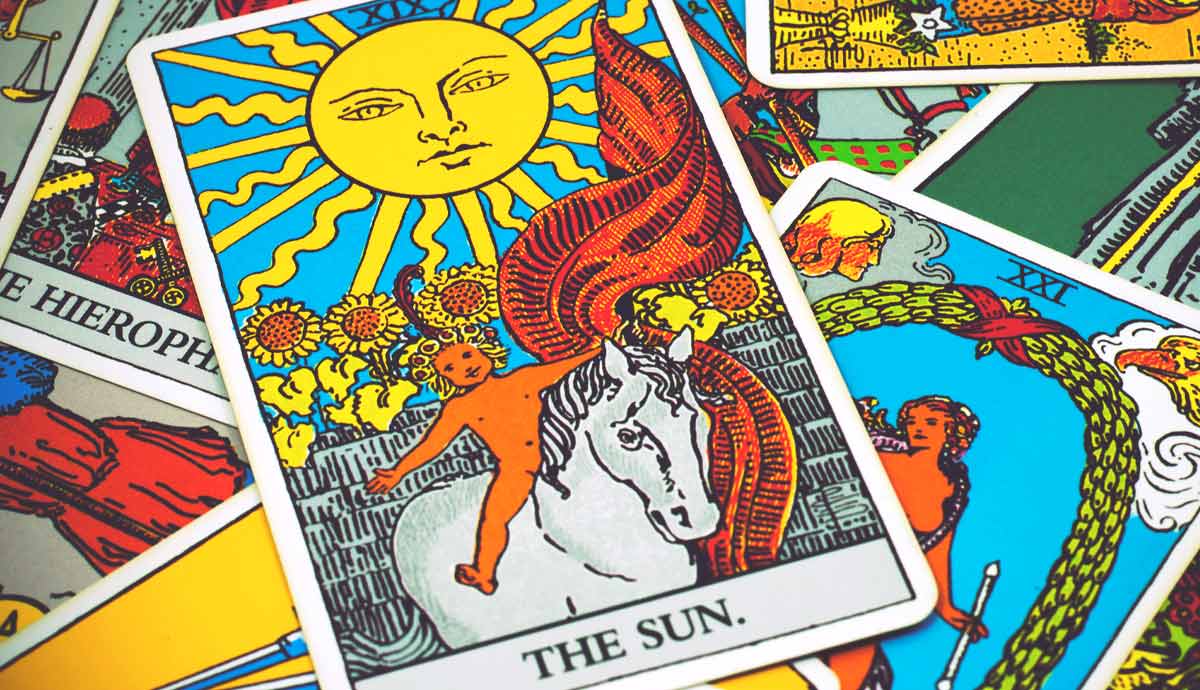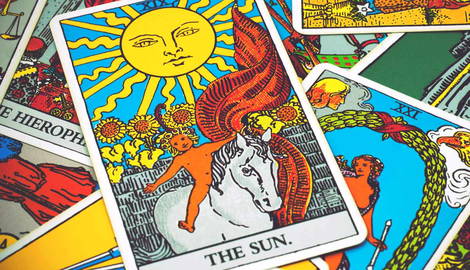
Recently, there has been a resurgence of interest in tarot cards but just where do these cards originate from? Ancient Egypt? China? France? Not as far as we’ve proven, though each of those regions plays a role. The oldest known tarot deck was made in the 15th century in northern Italy, and it wasn’t created for fortune-telling but as a card game. However, people realized the allegorical structure and universal symbolism of the tarot had great potential. Six hundred years later, it has become a versatile tool for self-empowerment, psychological therapy, and yes, divination.
The Source of the Word

Despite how much we know about the origin of tarot, there are still several unanswered questions that leave it somewhat open to interpretation. For instance, the exact etymology of the term “tarot” is unknown. Usually pronounced tare-oh, it is a French word that identifies the 78-card deck from Italy, where it was called Tarocco; plural Tarocchi. However, the word Tarocco was only used a century after the first decks appeared, and they were originally labeled “cartes da trionfi,” or “cards with trumps.”
Since we don’t know for certain the roots behind the word tarot, many theories have been established. Perhaps it references the Taro River in northern Italy, which could have powered early paper mills for cardmaking. Other ideas, particularly those that associate the word with the occult, have become more popular. Some people believe tarot may be derived from the name “Tara,” a goddess in both Hinduism and Tibetan Tantrism. The Hill of Tara is the seat of the ancient kings of Ireland and shares a pronunciation with the Roman word for earth, “terra.”
Others have made a connection with the Hebrew “Torah,” which comprises the first five books of the Old Testament. There’s a belief that tarot is linked with the word rota (Latin for “wheel”) or Tariqa or Tao (Arabic and Chinese respectively, both meaning “the Way”). Another hypothesis is that it comes from the ancient Egyptian phrase Ta-Rosh, translated to “the royal way,” or that it refers to the ancient Egyptian goddess Ator. This theory in particular has led to some interesting claims about the tarot’s origin.
The Egyptian Myth

The idea that tarot came from Egypt and was transmitted to Europe by wandering Romani people can be attributed to a French author by the name of Court de Gébelin. In 1781, he published his theory, claiming that the cards held the ancient wisdom of Egyptian high priests and priestesses. More specifically, he insinuated that the trump cards represented the creation of the world according to Hermes Trismegistus, the mythical teacher of Hermeticism. To strengthen this concept, he stated that the number seven, around which the tarot is based, was a sacred number to Egyptians and the symbolism was derived from their esoteric practices.
Indeed, some philosophical ideas from ancient times are present in the images of the tarot. Yet, there are several errors in de Gébelin’s theory. For one thing, we now know that the Romani did not come from Egypt, but India, and they arrived in Europe too late to have introduced tarot. In his essays, de Gébelin also linked the tarot to both the ancient Egyptian and Hebrew alphabets, but Egyptian hieroglyphics wouldn’t be deciphered until the following century. The occultists who latched on to de Gébelin’s ideas also neglected to realize that cards are printed on flexible paper — not brittle papyrus. The Chinese were the inventors of paper and may have been the first to make playing cards.
The Predecessors of Playing Cards

The origin of playing cards has long been debated. They were likely born in Asia — either China, Persia, or perhaps India — possibly as early as the 800s, but at least as old as the late 2nd century. Antique Chinese cards were nearly synonymous with paper money and were originally used in gambling. As papermaking was introduced to the Middle East, other card games were created and used for various purposes. One of these, the Mamluk deck, is believed to be the earliest set of cards brought to Europe.
By the 13th century, there are numerous mentions of playing cards in Europe, typically about them being banned due to their association with gambling. These decks were very similar to our modern-day ones, with four suits of numbered cards, often called pips, and three court cards. Different countries had different symbols for their suits. For instance, Germany had leaves, bells, acorns, and hearts, while France and England had spades, diamonds, clubs, and hearts. When it came to tarot, Italian suits naturally became the standard.
The Structure of a Renaissance Game

It is believed that the first cards to be truly identified as tarot, with a fifth suit of trumps, were created in northern Italy around the 1420s. Yet the oldest still in existence are the 271 cards from approximately 15 incomplete decks commissioned by the Visconti-Sforza family in the 1450s. These were hand-painted for the wealthy rulers of Milan and thus have been preserved. Most printed decks were seen as more ephemeral and haven’t survived history.
This deck and others created in the 15th century were made specifically to play the trick-taking game of tarocchi. It had a suit of twenty-one trumps, later called the Major Arcana, forty pip cards numbered Ace through ten, and sixteen court cards (which make up the Minor Arcana).
The Italian suits on the pip cards were swords, coins, cups, and batons (or wands). Many of the decks at this time had Christian symbolism, including images of the pope, the devil, and Adam and Eve. The game of tarrochi is still played in many places today. It is a distant ancestor of other trick-taking card games such as bridge, which uses one of the traditional four suits as a trump suit. But just what are the trump cards in the tarot supposed to symbolize?
The Fool’s Journey

Clearly, the Major Arcana are the distinguishing factor between tarot decks and playing card decks. As portrayed in the Tarot de Marseilles family of decks from the 16th century, they are a set of twenty-one cards labeled with Roman numerals, plus a Fool card. Later decks sometimes give the Fool the number zero, though this card was originally unnumbered. In any case, the Fool is symbolic of a “hero” which is why the story of the tarot trumps is often called “The Fool’s Journey.”
Altogether, the figures depicted in the Major Arcana are a representation of a Renaissance parade adapted from the earlier Roman triumph. The word trump is derived from triumph and comes to us through tarot. Each archetype in the parade is more powerful than the previous one, which is how you get the hierarchical structure. Though tarot decks were initially used to play a game, it wasn’t uncommon during the Renaissance to inject meaningful symbolism into art of any kind, even that used in popular pastimes. The triumph even inspired the poet Petrarch, celebrated in the fourteenth century as the writer of Trionfi. Thus, there is undisputed evidence that the Major Arcana is allegorical in meaning and contains esoteric symbolism, which is a major reason why it became more than just a card game.
Cartomancy with the Tarot

Remember de Gébelin? Well, for all his errors, he was certainly an inspiration for others to look closer at the images in tarot cards. In the 18th century, many occultists drummed up theories about tarot correspondences with other esoteric systems — so many in fact that it seems as if tarot symbolism must be much older and more global than we’ve proven. Everything from astrology to the Jewish and Christian Kabballah tradition has been found to have a somewhat convincing connection, and tarot fully entered the realm of mysticism.

Divination using the cards began to be more commonplace. A contemporary of de Gébelin’s named Jean-Baptiste Alliette, who wrote under the moniker Etteilla, is often deemed the first professional tarot reader. Though that’s debatable, Etteilla did come up with the term cartomancy for fortune telling using cards and commissioned the first tarot deck to be designed especially for divination. He either seized de Gébelin’s Egyptian theory, or developed similar ideas at the same time, and took it even further, stating that the tarot was a distorted version of the Egyptian Book of Thoth. During his lifetime, Etteilla published several texts on tarot, astrology, and alchemy, and influenced many of the occultists, such as those of the Golden Dawn, who came after him.
Two Golden Dawn Decks

As more European interest developed regarding esoterica, ancient wisdom, and mysteries around magic, societies centered around occult studies began to crop up. One of the most widely known and influential was the Hermetic Order of the Golden Dawn, established by three Freemasons in Great Britain in the late nineteenth century.
The Golden Dawn allowed both men and women to be members and drew on Hermeticism, ancient Egyptian religion, Christian mysticism, numerology, astrology, alchemy, and many other influences to develop their magic system. Among many of their prestigious members was the Irish poet William Butler Yeats, and three others who are famous in the world of tarot.
Arthur Edward Waite, dedicated scholar and author of many occult books, published The Pictorial Key to the Tarot in 1910, debunking tarot’s Egyptian origin and affirming that it was a representation of universal concepts that exist in the human consciousness but is untapped by most people. The illustrations in his book were drawn by American artist Pamela Colman Smith and published as a tarot deck by Rider and Company. Thus, the Rider-Waite-Smith, or RWS, tarot deck materialized and became the most influential tarot set from then on.
Another Golden Dawn member was the eccentric and controversial Aleister Crowley, who created his own version of the tarot with Lady Frieda Harris as the artist. The Thoth Tarot, as it’s called, is unusual and very different from the RWS. Nevertheless, it is still manufactured and studied today.
A Modern Mode of Insight

The tarot has gone through quite a transformation since its roots in the fifteenth century. A whole other dimension, based on Carl Jung’s archetypes and analytical psychology, has been added to the tarot, as well as different ways to approach the system. Today, there are thousands of different tarot decks, with more coming out all the time. Tarot has inspired artists and writers the world over, been featured in films and documentaries, and has even found its way into the offices of several therapists. From tarot reading call centers to online shops, more people are making a living as readers and more clients are gaining insights from the cards than ever before.
Sources:

Place, Robert M. The Tarot: History, Symbolism, and Divination. Penguin Books, 2005.
Wen, Benebell. Holistic Tarot: An Integrative Approach to Using Tarot for Personal Growth. North Atlantic Books, 2015.
Giles, Cynthia. The Tarot: History, Mystery, and Lore. Simon & Schuster, 1992.








